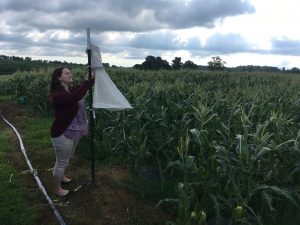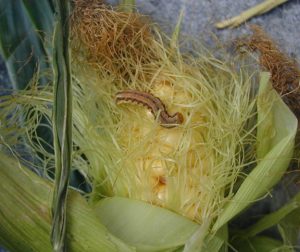Corn earworm (Fig. 1) and fall armyworm are two important pests of a number of agricultural crops in Virginia. Sweet corn, in particular, is extremely vulnerable to attack by the larvae (or caterpillars) of these moth pests. Monitoring moth catch in pheromone-baited traps can help IPM decision-making. Corn earworm is monitored using Heliothis traps (Fig 2). Pheromone lures are changed once per month and traps are monitored every few days. In general trap catch less than 1 per night means relatively low pest pressure and sprays can probably be spaced 5-6 days apart during silking. However, a catch of >1 or >13 moths per night means moderate and high pest pressure, respectively, and a more frequent spray interval is justified.
For fall armyworm, pheromone-baited bucket traps (Fig 3) are used to alert growers to the arrival of this late summer migrant from the South and its relative pest pressure.

Fig. 2. Heliothis trap being checked by summer intern Cailin Orgen for CEW moths in Frederick County, VA.
In 2018, with the help from 14 VCE agents, we are monitoring these pests on sweet corn farms in 17 different counties in Virginia. Moth Trap Catch Data are being recorded by: Kuhar Vegetable Entomology lab (Montgomery Co.); Phil Blevins (Washington Co.); Chris Brown (Franklin Co.); Jason Cooper (Rockingham Co.); Ursula Deitch (Northampton Co.); Helene Doughty (Accomack Co.); Roy Flanagan (VA Beach); Bob Jones (Charlotte Co.); Kenner Love (Page and Rappahannock Co.); Laura Maxey Nay (Hanover Co.); Steve Pottorff (Carrol Co.); Stephanie Romelczyk (Westmoreland Co.); Beth Sastre-Flores (Loudoun Co.); Laura Siegle (Amelia Co.); Rebekah Slabach (Halifax Co.); and Mark Sutphin (Frederick Co.). Data will be posted weekly.
Here are some trap catch results (moths per night) for some of the locations around Virginia for this week (note we do not have data for all locations yet):
Region County Field CEW/night FAW/night
Eastern Accomack Painter
Eastern Accomack Painter
Eastern Virginia Beach Cromwell 5.0 NA
Eastern Virginia Beach Henley 4.0 0
Eastern Virginia Beach Vaughan 1.0 0.2
Eastern Northampton Capeville 1.8 0
Eastern Northampton Cheriton 3.0 0
Eastern Northampton Eastville 1.1 0
Eastern Northampton Exmore 12.9 0
Eastern Westmoreland Field
Central Amelia Field
Central Hanover Wiblin
Central Hanover Haynes
Central Halifax
Central Halifax
Central Charlotte
Northern Loudoun
Northern Loudoun
Northern Rappahannock
Northern Page
Northern Frederick West Oaks
Northern Frederick Woodbine
Northern Rockingham
Southwest Montgomery Whitethorne 0.0 0
Southwest Montgomery Homefield Farm 1.0 0
Southwest Montgomery Wall 20.0 0
Southwest Franklin Wirtz
Southwest Carroll
Southwest Washington Abingdon









